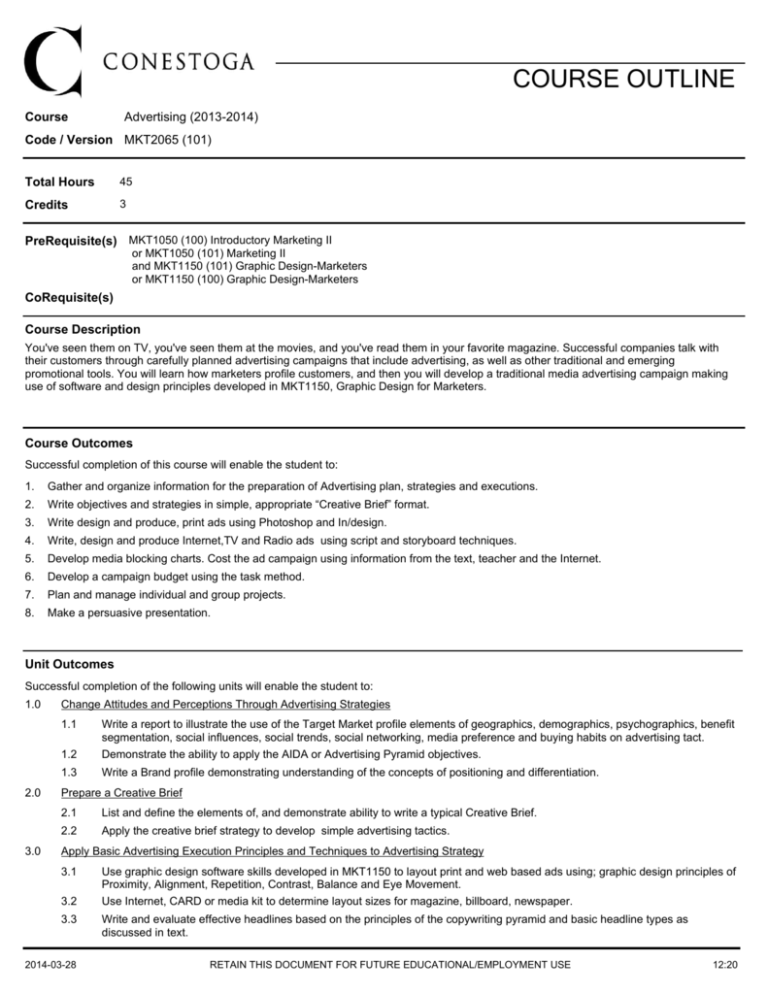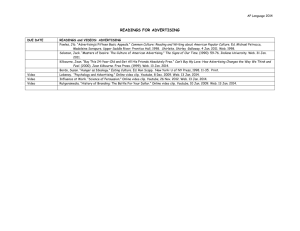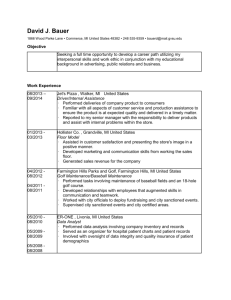
COURSE OUTLINE
Course
Advertising (2013-2014)
Code / Version MKT2065 (101)
Total Hours
45
Credits
3
PreRequisite(s) MKT1050 (100) Introductory Marketing II
or MKT1050 (101) Marketing II
and MKT1150 (101) Graphic Design-Marketers
or MKT1150 (100) Graphic Design-Marketers
CoRequisite(s)
Course Description
You've seen them on TV, you've seen them at the movies, and you've read them in your favorite magazine. Successful companies talk with
their customers through carefully planned advertising campaigns that include advertising, as well as other traditional and emerging
promotional tools. You will learn how marketers profile customers, and then you will develop a traditional media advertising campaign making
use of software and design principles developed in MKT1150, Graphic Design for Marketers.
Course Outcomes
Successful completion of this course will enable the student to:
1.
Gather and organize information for the preparation of Advertising plan, strategies and executions.
2.
Write objectives and strategies in simple, appropriate “Creative Brief” format.
3.
Write design and produce, print ads using Photoshop and In/design.
4.
Write, design and produce Internet,TV and Radio ads using script and storyboard techniques.
5.
Develop media blocking charts. Cost the ad campaign using information from the text, teacher and the Internet.
6.
Develop a campaign budget using the task method.
7.
Plan and manage individual and group projects.
8.
Make a persuasive presentation.
Unit Outcomes
Successful completion of the following units will enable the student to:
1.0
Change Attitudes and Perceptions Through Advertising Strategies
1.1
2.0
3.0
1.2
Write a report to illustrate the use of the Target Market profile elements of geographics, demographics, psychographics, benefit
segmentation, social influences, social trends, social networking, media preference and buying habits on advertising tact.
Demonstrate the ability to apply the AIDA or Advertising Pyramid objectives.
1.3
Write a Brand profile demonstrating understanding of the concepts of positioning and differentiation.
Prepare a Creative Brief
2.1
List and define the elements of, and demonstrate ability to write a typical Creative Brief.
2.2
Apply the creative brief strategy to develop simple advertising tactics.
Apply Basic Advertising Execution Principles and Techniques to Advertising Strategy
3.1
3.2
3.3
2014-03-28
Use graphic design software skills developed in MKT1150 to layout print and web based ads using; graphic design principles of
Proximity, Alignment, Repetition, Contrast, Balance and Eye Movement.
Use Internet, CARD or media kit to determine layout sizes for magazine, billboard, newspaper.
Write and evaluate effective headlines based on the principles of the copywriting pyramid and basic headline types as
discussed in text.
RETAIN THIS DOCUMENT FOR FUTURE EDUCATIONAL/EMPLOYMENT USE
12:20
COURSE OUTLINE
Course
Advertising (2013-2014)
Code / Version MKT2065 (101)
3.4
Write, edit and evaluate effective advertising copy according to copywriters principles and copywriting techniques.
3.5
Design an effective storyboard according to the principles of the copywriters pyramid and using the basic identifiers of
cinematic production devices.
List, identify and discuss typical creative execution techniques.
3.6
4.0
Media Strategies
4.1
List and discuss the strategic advantages and disadvantages of major print, Social Media and electronic media types.
4.2
Define and apply reach, frequency and continuity.
4.3
Explain the strategic uses of flighting, pulsing and continuous advertising.
4.4
Demonstrate an ability to select a suitable balance of reach and frequency and continuity based on cost and message
objectives dictated by the advertising pyramid, positioning strategies, lifecycle and market share.
Using Internet, or teacher provided materials, calculate ad costs for newspaper, magazine, television, billboard, Internet and
radio.
4.5
Required Student Resources
Tuckwell. Canadian Advertising in Action (9th). Pearson Prentice Hall..
Williams. The Non-Designer’s Design Book (3rd). Pearson Prentice.
Optional Student Resources
Williams, Robin. Williams Design Workshop (2nd). Pearson Prentice Hall.
Internet resources provided by teacher and text book
Periodicals: Advertising Age, Marketing, Communication Arts
Evaluation
The minimum passing grade for this course is 55 (D).
In order to successfully complete this course, the student is required to meet the following evaluation criteria:
Lab & Lecture Assignments and Cases
60.00
Midterm and Final
40.00
100.00 %
Achieve an overall (weighted average) grade of greater than or equal to 55% on major tests (note: major tests are defined as those that are
worth no less than 20% of the final grade in the course).
All requirements must be met in order to pass the course.
Other
Conestoga College is committed to providing academic accommodations for students with documented disabilities. Please contact the
Accessibility Services Office.
Prepared By
Steve Finlay
School
Business and Hospitality
Date
2013-06-05
2014-03-28
© Conestoga ITAL
RETAIN THIS DOCUMENT FOR FUTURE EDUCATIONAL/EMPLOYMENT USE
12:20
COURSE OUTLINE
Course
Advertising (2013-2014)
Code / Version MKT2065 (101)
2014-03-28
RETAIN THIS DOCUMENT FOR FUTURE EDUCATIONAL/EMPLOYMENT USE
12:20








